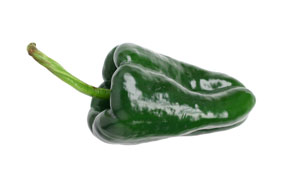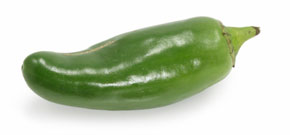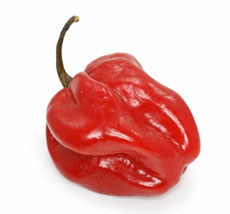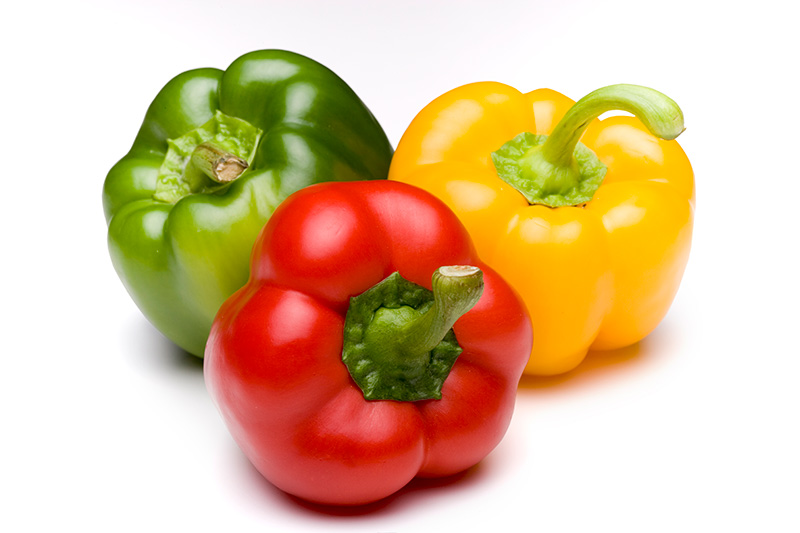Pepper varieties
Poblano Pepper

Jalapeno Pepper

Habanero Pepper

Special Diet Information
Coumadin® (warfarin)
Peppers contain a low amount of Vitamin K and should be safe for
Coumadin users in moderate amounts.
Lactose
There is no lactose in peppers.
Sodium
There is very little sodium in peppers.
GERD / Acid Reflux
Many peppers are too spicy for those with GERD, and often the less
spicy peppers, such as bell peppers, are too acidic for those
with GERD. Cooking the peppers slowly and for a long time may
make them tolerable for some.
Gluten Sensitivity
Peppers are a gluten free food.
Green Bell Peppers
Nutrition Facts
Serving size = 4 ounces
![]()
Amount Per Serving
| Calories 24 | Calories from Fat 0 |
| % Daily Value |
| Total Fat 0g | 0% |
| Saturated Fat 0g | 0% |
| Monounsaturated Fat 0g | |
| Trans Fat 0g | |
| Cholesterol 0mg | 0% |
| Sodium 4mg | >1% |
| Total Carbohydrates 5g | 2% |
| Dietary Fiber 2g | 7% |
| Sugars 2g | |
| Protein 1g |
| Vitamin A 7% | Vitamin C 134% |
| Calcium 1% | Iron 2% |
| Vitamin K 8.3 mcg | Potassium 175 mg |
| Magnesium 10 mg | |
Red Bell Peppers
Nutrition Facts
Serving size = 4 ounces
![]()
Amount Per Serving
| Calories 35 | Calories from Fat 0 |
| % Daily Value |
| Total Fat 0g | 0% |
| Saturated Fat 0g | 0% |
| Monounsaturated Fat 0g | |
| Trans Fat 0g | |
| Cholesterol 0mg | 0% |
| Sodium 3mg | <1% |
| Total Carbohydrates 7g | 2% |
| Dietary Fiber 2g | 8% |
| Sugars 4g | |
| Protein 1g |
| Vitamin A 63% | Vitamin C 213% |
| Calcium 1% | Iron 2% |
| Vitamin K 5.5 mcg | Potassium 211 mg |
| Magnesium 12 mg | |
Ingredient Information
Peppers
Like eggplants and tomatoes, peppers are a member of the nightshade family. The stores are full of peppers in early summer. It seems like sometimes there are almost too many choices.
The most common pepper in markets today is the sweet pepper or bell pepper. In the U.K. they are generally referred to as peppers while in Spain one would buy pimientos. There are a number of varieties and all are in the Capsicum family, making them a cousin to chili peppers such as jalapenos and habaneros.
Red bell peppers are simply green peppers that have been allowed to ripen on the vine longer and are, consequently, sweeter, with less of the herbaceous and slightly bitter flavor than their green bell pepper cousin. Yellow, orange ,and purple varieties are widely available now as well, each with subtly different flavors.
Poblanos range from very dark green to almost black. They are mildly spicy with a heat index of mild to medium. The darker pepper has a more intense flavor. As poblano peppers mature they turn a reddish brown. Dried poblanos are known as Ancho chilis.

Look for peppers that are firm to the touch and have no dark spots or obvious bruising. One sign of a pepper that is not fresh is when there are small pits in the skin.
Green bell peppers have twice the amount of vitamin C as oranges and red or yellow bell peppers have 4 times as much. They are packed with antioxidants as well, including lycopene and carotene. The antioxidant levels are generally higher in red, yellow or orange than with green peppers.
Because one of the best parts of peppers is their crunchy texture, look at them very carefully for freshness. One sign of a pepper that is not fresh is when there are small pits in the skin. Look for peppers that are not soft and have no dark spots or obvious bruising. Store them in plastic bags in the crisper drawer in your refrigerator.
To roast peppers, start by setting the oven on broil. Wash the peppers and place them in the oven about 4 to 6 inches under the broiler. Check on them every two minutes or so, turning them one quarter turn at a time until they are well charred on the outside. You can do this over the burner or grill but I find that you have to be more careful than with the broiler.
When the pepper is well charred remove it from the oven and place in a paper bag. Close the bag and allow the pepper to cool completely. The skin will then slip off easily and once sliced open it is seeded just as easily.
One time I was doing a demonstration of a recipe using roasted peppers and the host asked if he could use bottled red peppers. The answer is yes. While some are packed in oil, most are packed in water with a little vinegar. Either way, they rarely have much, if any, salt. I have tested recipes with fresh and bottled peppers and there is a difference in the fresh roasted flavor not coming through as well with the bottled peppers, but overall they are really good. I have also used bottled roasted yellow peppers with similar results.
There are dozens of hot peppers available to you, and if you are so inclined, there are even hot pepper societies for the appreciation of these spicy delicacies. Dr. Gourmet recipes generally call for milder types like anchos, chipotles and jalapenos.
Chipotles are actually jalapeno chilis that have been smoked and dried. The intense flavor is spicy and has lovely undertones of smoke, chocolate and sweet peppers. If the peppers are not going to cook for very long, I will often soften them by steaming for about ten minutes.
Usually found in markets, dried chipotles are also sold packed in cans in adobo, which is a spicy sauce made of vinegar, dried chili peppers, herbs and spices
The heat of chili peppers is measured in Scoville units, a scale that was invented by Wilbur L. Scoville in 1912. He based this on the number of parts of sugar water that it would take to dilute the extract of chilies to the point that there is a barely detectable burn. While this seems a bit obsessive for my taste, pretty much anything over 5,000 scoville units is hot (let alone the sauces and peppers that advertise themselves as being 10, 20 or 100 times that hot).
Practically speaking, you will find only a handful of pepper types in a typical grocery store. The most common in the U.S. markets (from mild to hot) are:
Mild (1,000 – 2,000
scoville units)
Poblano
Ancho (smoked poblano)
Medium to hot (2,000 – 5,000
scoville units)
Jalapeno
Chipotle (smoked jalapeno)
Serrano
Very Hot (1,000,000 – 3,000,000
scoville units)
Scotch Bonnet
Habanero
Thai
4 ounces peppers = 30 calories, 0g fat, 0g sat fat, 0g mono fat, 1g protein, 7g carbohydrates, 3mg sodium, 0mg cholesterol
Related Topics
Dr. Gourmet's Health and Nutrition Bites
Hot Research!
There has been research that indicates eating meals
spiced with chilies increases fat burning as well as the amount of energy
used by the body. Researchers have felt that this might be an approach to
fighting obesity, and in an interesting study reported in this month's American
Journal of Clinical Nutrition (2006;84:63-69), a group of 36 volunteers
agreed to eat chilies for the advancement of science.
More hot research!
In a follow-up study reported in the European Journal
of Clinical Nutrition (2007;61:326-333), 36 volunteers were randomly assigned
to a bland or chili-containing diet, then after four weeks of following
that diet, they switched to the opposite diet for a further four weeks.
The chili-containing diet included the equivalent of 30mg per day of capsaicin,
the active ingredient in chilies.
Ask Dr. Gourmet
How much Vitamin K is in green, red, yellow and orange peppers?
How long should I store chipotles in adobo in my refrigerator?
Does cooking vegetables cause them to lose their nutrients?
Does washing remove the pesticides from foods?
Recipes Using Peppers
Cheese Stuffed Peppers
Chicken Fajitas with Roasted Red Peppers
Shrimp with Peppers
Black Bean Stuffed Peppers
Roasted
Red Pepper Soup | Low Sodium Roasted Red Pepper Soup
Red Pepper Pesto
Creamy Poblano and Chicken Soup
Southwest Venison Cheeseburgers
Sweet Red Pepper Barbecue Tuna
Chili Rellenos
